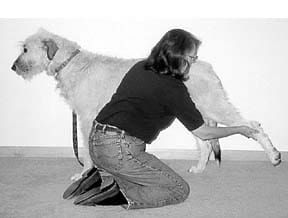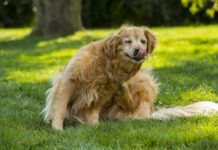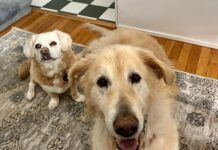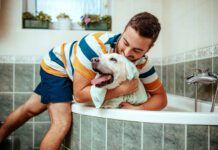Several readers have contacted me with reports of their growing massage skills. Learning and practicing each new massage technique is a thrill, and now that you have accomplished several techniques it is time to put them all together into a massage routine for your dog. The following routine is just a guideline to help get you started. Once you have tried it a time or two, you will naturally sequence the massage moves into a routine to suit you and your dog. Soon each massage will be different and will meet your changing needs and moods.
Getting in “massage mode”
To begin, clear your mind of all miscellaneous thoughts that tend to stray into your consciousness. Focus on your dog, and set your intent for the massage. Do you intend the massage to relax, reduce stress, improve flexibility and range of motion, or relieve discomfort from a chronic condition like arthritis? Whatever your reason, greet your dog verbally or mentally, express your intent, and ask permission to begin. Some folks speak in soothing tones while others use mental pictures to communicate with their pal. Remember, it is important that the massage be a pleasant experience for the dog.

The goal is to massage the whole dog, but we generally massage the face and head then one side of the body at a time. The effleurage move is used to “open” and “close” each region of the body as the massage routine progresses. As you use effleurage to open an area it stimulates blood flow which brings oxygen and nutrients to the tissues and prepares the region for other, sometimes deeper massage work. When massage in one area is completed, the area is closed with effleurage, which encourages the removal of toxins and metabolic wastes that can be released during massage.
Start at the beginning
I suggest initiating massage with effleurage to the face and head, since I think most dogs interpret the petting motion as a friendly gesture. Both sides of the face and head can be massaged at one time. Follow a few effleurage strokes with digital circles (finger pads only) to the face. You might concentrate on the large masseter or jaw muscle and the areas that surround the base of the ears. As you close the face and head with effleurage, make the strokes long and continue them on to the neck and shoulder to open these areas.
You may wish to use more digital circles on the neck muscles next to the vertebral column. It is beneficial to make a series of small digital circles near the vertebrae and a second series of slightly larger circles about one-half inch farther from the vertebrae. Of course, the area that you cover and the number of passes that you make is somewhat dependent on the size of the dog. Continue work by moving to the shoulder. A cross-fiber friction technique like the angel wing technique separates muscle fibers and can relieve muscle spasms. Remember that the stroke mimics the thumb motion of a hitchhiker. You may wish to start with a light pressure and increase it slightly as you proceed. Use two or three effleurage strokes to close the area.
It is time to open the front leg with effleurage. Remember to start at the toes and work up so you are going with the flow of venous blood toward the heart. You can follow this with digital circles around the joints, and on the larger upper arm muscles. Around the joints, digital circles will alert you to any swelling or discomfort that is present.

Now take the paw gently in your hand and use passive touch or a few sets of two or three compressions to increase circulation. Now work on maintaining and improving flexibility with passive stretching of the limb. Only stretch until the dog shows resistance. Do not stretch past this point. Close the limb with two or three effleurage strokes up the leg.
Open the chest and trunk with several effleurage strokes. Two or three passes of slow digital circles and/or two or three passes of thumb gliding along the spine are great to look for muscle spasms or other types of discomfort while relaxing the muscles. In the thumb glide, the thumb leads the way and the fingers just tag along. Start the strokes near the vertebral column and make each successive pass a little farther from the spine. You may also wish to thumb glide between the ribs. Close the chest and trunk with long effleurage strokes that cover the large hip muscles to open this area.
Mixing techniques
As for the shoulder, angel wing is a great technique for the large hip muscles. The routine for the hind limb is similar to the one for the front leg. You may also wish to do compressions or digital circles on the large muscles of the upper limb, digital circles around the joints, and passive touch or compression on the paw. Do some gentle passive stretching of the limb, and you are ready to close with effleurage up the leg.
If the dog is standing, go to the other side and repeat the same massage routine starting at the neck and continuing toward the tail. If the dog is lying down, you must gently roll him over or ask him to stand and reposition himself so you can massage the other side. When you have completed the massage, you may wish to make a few sweeping effleurage strokes from head to tail. End the session with doggy bone stretches to both sides to improve flexibility. It is very good for the dog and ends the massage on a very positive note. Be sure to thank the dog!
Congratulations – you have just completed a massage for your dog. The benefits to him were many. How do you feel? The positive mood that you have surely reached is an additional but sometimes ignored benefit of canine massage.
Also With This Article
Click here to view more on “Canine Massage Therapy”
-By C. Sue Furman
Author Sue Furman is an Associate Professor in the Department of Anatomy and Neurobiology at Colorado State University in Ft. Collins, CO. In addition to her academic career, she is active as a free-lance writer and teaches equine and canine massage classes.






